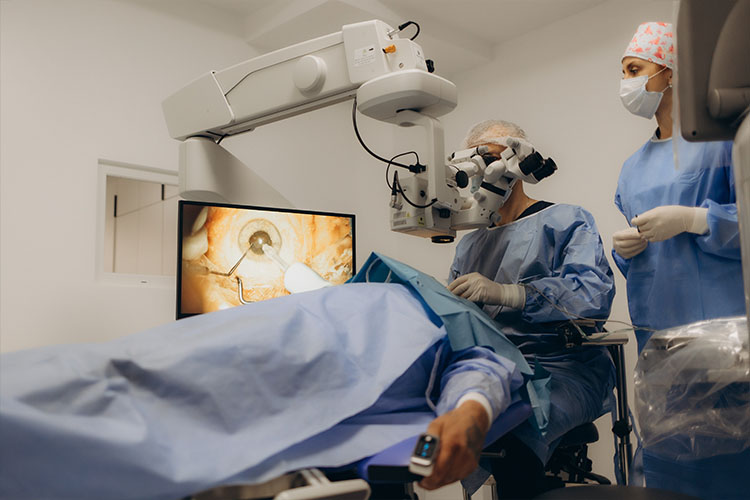Overview
Eye cancer is a rare condition where abnormal cells grow uncontrollably in or around the eye. It can originate in the eye itself (primary eye cancer) or spread to the eye from other parts of the body (secondary eye cancer). The most common type of primary eye cancer in adults is uveal melanoma, while retinoblastoma is more common in children. Other forms include lymphoma and squamous cell carcinoma of the conjunctiva.
The effects of eye cancer depend on the type and stage of the disease. Early symptoms may include blurred vision, a dark spot on the iris, partial or complete vision loss, or a noticeable change in the appearance of the eye. In advanced cases, the cancer may cause pain, swelling, or visible growths. If untreated, eye cancer can lead to severe complications, including permanent blindness and metastasis to other parts of the body.
Treatment for eye cancer varies based on the type, size, and location of the tumor, as well as the patient’s overall health. Common treatments include radiation therapy, which targets and destroys cancer cells, and surgery, which may involve removing the tumor or, in severe cases, the entire eye (enucleation) to prevent the spread of cancer. Other options include laser therapy, cryotherapy (freezing), and chemotherapy for cancers that have spread or cannot be managed with localized treatments.
Advancements in diagnostic imaging and treatment techniques have significantly improved outcomes for patients with eye cancer. Early detection and a tailored treatment plan can preserve vision, improve quality of life, and reduce the risk of life-threatening complications.
Table of Contents
When to See a Doctor
Early detection of eye cancer greatly increases the chances of effective treatment and preservation of vision.

Signs to see a doctor:
- Changes in vision. Sudden or unexplained changes in vision, such as blurriness, partial vision loss, or seeing flashes of light, may indicate a serious eye condition that requires immediate attention.
- Unusual spots or growths. Dark spots, lumps, or growths on the iris, sclera (white of the eye), or conjunctiva (the membrane covering the eye) should be evaluated by a doctor, as they could be early signs of eye cancer.
- Pain, redness, or swelling. Persistent discomfort, redness, or swelling in or around the eye that doesn’t resolve with typical remedies warrants professional evaluation.
- Family history or genetic predisposition. Individuals with a family history of eye cancer, such as retinoblastoma, or genetic conditions like dysplastic nevus syndrome should have regular eye examinations to monitor for signs of cancer.
- Unexplained changes in the appearance of the eye. Bulging, changes in eye color, or irregularities in pupil shape could indicate an underlying problem and should be checked promptly.
If these symptoms persist or worsen over time, it’s important to see an ophthalmologist, a specialist in eye health. Early diagnosis is critical for managing the disease effectively, preserving vision, and reducing the risk of the cancer spreading to other parts of the body.
What Type of Doctor to Seek
If you suspect eye cancer or experience symptoms such as vision changes, unusual growths, or eye pain, your first step should be to consult an ophthalmologist, a medical doctor specializing in eye health. Ophthalmologists can perform detailed eye exams and imaging tests, such as ultrasounds or optical coherence tomography (OCT), to identify abnormalities in or around the eye. They are trained to diagnose eye conditions, including eye cancer, and will guide you on the next steps if further evaluation is needed.
If eye cancer is diagnosed or strongly suspected, you may be referred to an ocular oncologist, a specialist who focuses on cancers of the eye. These doctors are experts in managing eye tumors and may collaborate with other specialists, such as medical oncologists or radiation oncologists, to create a comprehensive treatment plan. For advanced cases involving metastasis, a multidisciplinary team ensures that all aspects of your condition are addressed.
What to Expect from Your Visit to a Doctor
When visiting a doctor for concerns about eye cancer, your appointment will begin with a detailed discussion of your symptoms, medical history, and any family history of eye-related conditions or cancers. The doctor will perform a comprehensive eye examination, which may include dilating your pupils to examine the retina and other internal structures of the eye. They will also look for any visible growths or abnormalities on the surface of the eye.
If cancer is suspected, the doctor may recommend additional diagnostic tests such as an eye ultrasound, optical coherence tomography (OCT), or fluorescein angiography to examine the blood vessels in the eye. In some cases, a biopsy may be performed to confirm the diagnosis. Once the results are available, the doctor will discuss your diagnosis, explain potential treatment options, and provide a plan tailored to your condition. Be prepared to ask questions or raise any concerns during the visit to fully understand your diagnosis and treatment plan.
Eye Cancer Treatment Options

The treatment for eye cancer depends on its type, size, location, and severity. A combination of treatments may be used to eliminate the tumor, manage symptoms, and preserve vision whenever possible. Here are the most common treatments for eye cancer:
- Surgery. Surgery is one of the primary treatment options for eye cancer, particularly when the tumor is small and vision in the affected eye can still be preserved. The procedure involves removing the tumor while minimizing damage to surrounding tissues.
- Enucleation. Enucleation is a surgical procedure in which the entire affected eye is removed. This is typically performed when the tumor is large, vision is already lost, or the cancer poses a risk of spreading. After the eye is removed, it is replaced with an artificial eye to improve appearance.
- Brachytherapy. This form of internal radiotherapy involves placing small plaques containing radioactive material near or inside the tumor to target and destroy cancer cells. It is particularly effective for certain types of eye cancer, like small to medium-sized ocular melanomas.
- External radiotherapy. In external radiotherapy, high-energy beams are directed at the tumor from outside the body to kill cancer cells. It is a less invasive option compared to brachytherapy and is often used when internal placement is not feasible.
- Chemotherapy. Chemotherapy uses drugs to kill cancer cells or stop their growth. It can be administered orally, intravenously, or through injections. While it is a common treatment for many cancers, it is not as effective for certain eye cancers, such as ocular melanoma, but may be used for lymphoma or retinoblastoma.
- Symptom management. In addition to these treatments, doctors may prescribe medications to alleviate symptoms like redness, inflammation, and pain. Pain relievers and anti-inflammatory drugs can help improve the patient’s comfort during treatment.
Each treatment is tailored to the patient’s specific condition, focusing on eliminating the cancer while preserving as much vision and quality of life as possible. Advancements in medical technology and personalized care plans continue to improve outcomes for individuals diagnosed with eye cancer.
Eye Cancer Prognosis
The prognosis for eye cancer depends on factors such as the type, size, and location of the tumor, as well as how early it is detected and treated. Each treatment option provides unique benefits and outcomes. Here’s a look at the prognosis for each approach:
- Surgery. Surgery offers a favorable prognosis when tumors are small and confined to the eye. Removing the tumor while preserving as much of the eye as possible often results in good long-term outcomes, though follow-up is crucial to monitor for recurrence.
- Enucleation. While enucleation involves the loss of the affected eye, it is a life-saving procedure for large or advanced tumors. Patients typically recover well with an artificial eye and can lead a normal life, although vision is limited to the remaining eye.
- Brachytherapy. Brachytherapy is highly effective for small to medium-sized tumors, especially ocular melanomas. It preserves the structure of the eye and often maintains partial vision, with a low risk of recurrence in localized cancers.
- External radiotherapy. External radiotherapy is effective for controlling tumor growth and reducing the risk of spread, particularly in cancers that cannot be surgically removed. Side effects may include some damage to surrounding healthy tissue, but advancements in precision techniques have improved outcomes.
- Chemotherapy. Chemotherapy is most effective for systemic or metastatic cancers, such as lymphoma or retinoblastoma. While it is less effective for ocular melanomas, it can improve survival rates for cancers that respond well to this treatment.
With early diagnosis and the appropriate treatment, many patients with eye cancer achieve positive outcomes. Regular follow-ups and advancements in therapy continue to enhance survival rates and quality of life for individuals battling this condition.


